DOLPHIN FLEET NATURALIST NOTEBOOK JUNE 20TH-26TH
On June 20th we sailed out to Peaked Hill with gray skies, light wind and moderate seas. We observed 16 humpback whales and 2 finback whales and identified Zeppelin, Canopy, Glo, Walrus, Trident and Nile. The whales demonstrated a myriad of behaviors including several active and feeding behaviors. Glo’s calf was putting on quit a show as s/he was breaching out of the water. Breaching requires a tremendous amount of energy and strength, making it impressive to see a young calf display such an energetic behavior. While Glo’s calf was busy occupying its self, Glo had found a patch of sand lance and was open mouth and kick feeding. Nursing females are under extreme energetic pressure as they have depleted their blubber reserves from nursing their young while fasting in the Caribbean. Because of the often-abundant supply of sand lance, Stellwagen Bank often hosts many nursing females and is frequently referred to as a nursery ground. Other areas such as the Bay of Fundy are home to a slightly different demographic, as older male whales usually inhabit the cool waters. It is thought that older male whales head further north to feed because they have developed techniques to catch fasting schooling fish that are higher in nutrients such as herring and mackerel. Humpbacks are known to return to the feeding ground their mother brought them to, so it is likely that Glo’s calf will become a regular visitor of Stellwagen Bank.
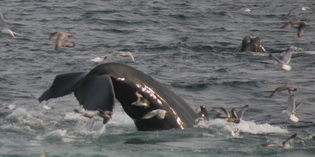
Glo (kick feeding)
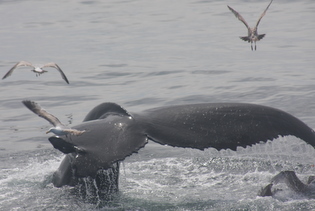
Glo (dorsal flukes)
We left Provincetown harbor on June 21st with gray skies, limited visibility and moderate winds and seas. Despite the unfavorable conditions, we had great sightings and observed 4 humpback whales and 2 finback whales. We identified two adult humpbacks, Walrus and Scylla. Many of the whales appeared to be demonstrating similar behaviors, as they were going on high-fluking dives, which is often suggestive of deep dives. Humpbacks do spend approximately 10% of their time at the surface, leaving many of their sub-surface behaviors unknown. Sometimes when humpbacks are going on high and long-fluking dives its because they are bottom feeding—scooping up sand lance that are hiding in the sandy substrate. Many humpback whales have scuffmarks on the side of their jaw from bottom feeding; some will even have open wounds on their jaw if they were just recently feeding.
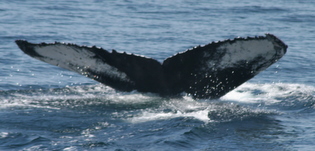
Scylla
We sailed out to the South Edge of Stellwagen Bank on June 24th with gray skies, light wind and moderate seas. We observed 11 humpback whales, 1 finback whale and 1 basking shark. Identified whales included Scylla’s 2008 calf and Liner. Throughout the day the whales were surface feeding, employing various feeding techniques such as bubble clouds, bubble nets and kick feeding. Judging by the whale’s behavior, it is likely that they found a dense patch of sand lance near the surface. The bubbles released by the whales made the fish aggregate tightly together (a strategy fish employ to avoid predation) and then the kick feeding shocked the prey making them disoriented and easier to catch. After going on a short dive, the whales surfaced with open mouths full of water and fish. Of course the whales cannot consume the salt water just as we cannot, so they closed their mouths and swam forward with their chins above the water—this is a technique called dragging. While dragging the whales contract their throat muscles and press their tongue against their baleen thereby forcing out all the salt water and trapping the fish inside their mouths. These humpbacks need to consume approximately one tone of sand lance per day, so while on Stellwagen Bank the whales are constantly foraging.
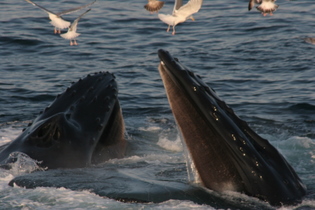
Surface feeding humpbacks
On June 25th we sailed out to the Southeast Corner of Stellwagen Bank with bright skies, fog, light wind and calm seas. Despite the poor visibility we had excellent sightings as we observed 12 humpback whales, 3 finback whales and 1 gray seal. We identified Dome, Rocker, Freefall, Circus, Backgammon, Rapier, Stub, Walrus, Pitcher and Palette. Throughout the day we observed sporadic surface feeding with bubble clouds, kick feeding and open mouths. We also observed active behaviors from a calf that was breaching and got a close boat approach by a curious humpback.
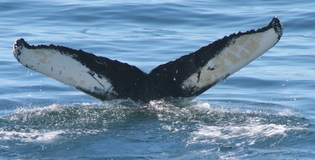
Freefall
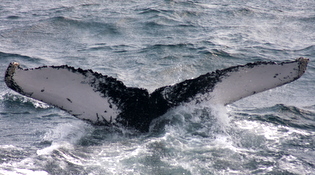
Rocker
On July 26th we traveled to Peaked Hill with gray skies, fog, light wind and calm seas. Although our sighting conditions were challenging we had outstanding sightings as we observed 17 humpback whales and 3 harbor seals. We identified several mother and offspring pairs including Abrasion and calf, Tulip and calf, Fern and calf and Palette and calf and many singles including Vibes’ 2008 calf, Scylla’s 2008 calf, Snare, Barb, Division, Sundown, Dome, Release and Ivory. Abrasion’s calf put on quite a show as s/he was breaching right beside the boat. Meanwhile, Barb, Division and Sundown we busy feeding on sand lance. To our surprise the active behaviors continued throughout the day with tail breaches, spinning breaches, chin breaches, flipper slapping and open mouth feeding and bubble clouds! On our way back to Provincetown we observed dogfish in between Race Point and Herring Cove. Dogfish are small (3-4 feet) gregarious sharks that commonly inhabit Cape Cod waters. These sharks commonly feed on fish (including other sharks), squid and octopus. Unfortunately, because of their schooling behavior, dogfish are commonly caught in large numbers as bycatch in trawl and longline fisheries. In Britain, however, these fish are eaten as an inexpensive substitute for Cod or Plaice as fish and chips.
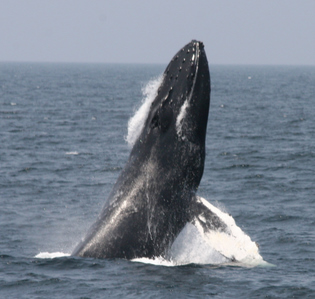
Chin breach
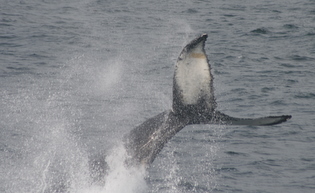
Tail breach (Scylla’s 2008 calf)





